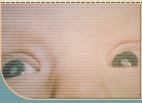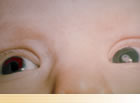
Important Information for Parents and Families
Cataracts and Aphakia
Light enters the eye through the lens. The lens focuses this light onto the back of the eye (retina) so we can see. Just as a smudged window does not let enough light into a room, so a clouded lens (cataract) does not let enough light into the eye. How much of the lens is blocked by the cataract affects how much someone can see. There are many different reasons why a cataract occurs. Your doctor is the best person to answer your specific questions about your child's vision and cataract.
Absence of the lens of the eye is known as aphakia. It is usually associated with the surgical removal of a cataract but may also result from a wound or other cause. Without the lens, the eye cannot adjust its focus for seeing at different distances. Contact lenses or eyeglasses are used to correct the vision of someone with aphakia, or an artificial lens is inserted to replace the lens removed. A person with aphakia will benefit from good, but not excessive, lighting and high-contrast reading materials.

This diagram is used by permission of Dr. Anil Rao,
Metropolitan State College of Denver, Department of Biology
